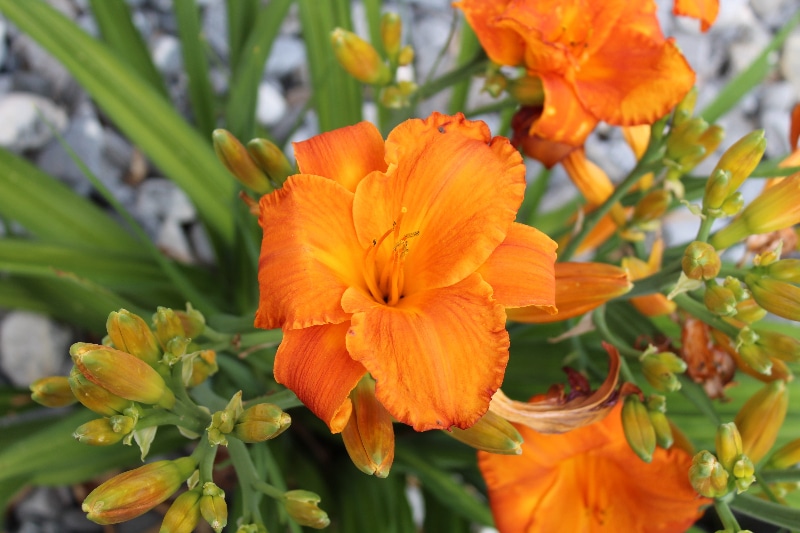If you want to know how to prepare daylilies for winter, you can simplify it into two steps. This article will also discuss the other practices you can do to these perennials to help them handle the cold season. Daylilies may be rugged, but knowing how to care for them in the winter is advantageous in the long run.
Those who grow daylilies in pots may have an easier time transitioning to the cold weather. Either way, you can always use a greenhouse to shelter your plants if your region experiences harsh winters. You should also check the varieties that you’re growing to ensure that they will thrive in your location.

How To Prepare Daylilies For Winter Successfully
Before anything else, it’s worth clarifying a common misconception with the terminologies related to daylilies. You have probably seen information about digging their bulbs for overwintering; however, the correct term here is that these bulbs are the tuberous roots of the daylilies themselves. These tubers are what you’ll dig for preparing daylilies for winter.
Step #1. Digging
The first step in preparing daylilies for winter is cutting the plants by the end of fall. You want to prune the daylilies close to the ground when their foliage turns brown, typically after the flowering period. This way, the dead foliage won’t compete with the energy source of the plant.
You can then dig out the tubers by loosening the soil around the perimeter of the daylily plant. Remember to allocate some space away from the clump to prevent hitting and damaging the tubers. You can then pull the tubers from the soil by gently loosening them with a trowel.
Step #2. Tuber preparation
Before you keep the tubers in a protected and stable location like the greenhouse, you must prepare them first. This will prevent diseases and their potential transmission among the tubers. You can simply use your fingers to brush off the soil from the tubers and shake the roots to remove the soil in them as well.
However, don’t be tempted to wash the tubers because this will potentially encourage rot. You must also check for any signs of damages among the tubers and separate them. You shouldn’t include unhealthy and shriveled roots in the daylilies that you’ll overwinter as well.
You can put the tubers in a cardboard box with peat moss and then cover each layer with peat moss once more. Place the box somewhere cool and dry with adequate ventilation to prevent rot and fungal growth. You can use the greenhouse for this, but always check the tubers for damaged ones and remove them immediately.
Pruning Daylilies For Winter
Besides overwintering the tubers, pruning the daylilies themselves is part of winter care, as you have briefly read earlier. You want to prune the dead foliage and cut the plants close to the ground by fall. You can also just leave the brown foliage in your plants and remove them by spring in some areas.
When pruning daylilies, don’t forget to use sharp and sterilized tools. Remember that plants are at risk for diseases during pruning, and diseases and pests are easily transmissible. You want to soak your tools for at least an hour in a bleach solution and then let them air dry before using.
Semi-evergreen vs evergreen daylilies
Another consideration when preparing daylilies for winter is their type. For example, classify your plants into semi-evergreen and evergreen daylilies as they have different suitable practices for the cold season. Semi-evergreen daylilies tend to lose their foliage in the winter, while evergreen daylilies, from the name itself, will always be green amidst the cold season.
You may also notice the decline in your semi-evergreen daylilies during the freezing periods in fall before going dormant by the beginning of winter. During dormancy, you will see these plants as sprouts that will get active in spring. Therefore, you must maintain these daylilies by removing the dead leaves around the sprouts.
Evergreen daylilies will also slow down in growth during winter, but their foliage will remain green. However, it’s better to keep them in the greenhouse if your area experience freezing temperatures as they will damage the daylilies into mush. Like your care for semi-evergreen daylilies, you must also get rid of the damaged or decaying foliage of evergreen daylilies during winter.
How To Mulch Daylilies For Winter
After pruning daylilies, you must also mulch their beds for wintering. You can use two inches of leaf mulch and replace it per year as it will rot. More so, remember to stop feeding and watering your daylilies in preparation for winter to encourage them to go dormant.
Conclusion
Growing plants year-round should be comfortable if you know how to provide winter care. Regardless if you have semi-evergreen or evergreen types, learning how to prepare daylilies for winter is vital to help your plants cope during this season. You can encourage your plants to undergo dormancy, but you must also learn how to store tubers, prune the plants in the fall, and mulch the daylilies as part of their winter regimen.
Digging up the tubers and storing them is no different than what you’ll do with other tuberous plants. You can use a greenhouse or any dry and cool place for storage. More so, you must remove the brown foliage of your plants and mulch the ground before winter starts.
